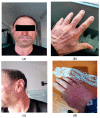The Benefits and Challenges of the Multimodal Treatment in Advanced/Metastatic Malignant Melanoma
- PMID: 37175025
- PMCID: PMC10178057
- DOI: 10.3390/diagnostics13091635
The Benefits and Challenges of the Multimodal Treatment in Advanced/Metastatic Malignant Melanoma
Abstract
Currently, the treatment of malignant melanoma offers the longest and the most studied experience of innovative treatments in malignant pathology. The algorithm of the therapeutic decision in advanced or metastatic melanoma must comprise: the timing of the therapeutic initiation, the sequencing of the specific oncological treatment (radiotherapy and chemotherapy still being therapeutic alternatives in selected cases), the diagnosis and the management of adverse reactions. We present the case of a patient diagnosed with metastatic malignant melanoma in November 2019, who progressed successively under new systemic treatment throughout the 3 years of treatment and experienced skin reactions of various degrees of severity. The comprehensive response to secondary hilar pulmonary lymphatic determinations under subsequent chemotherapy was specific to the presented case. The occurrence of vitiligo secondary to immunotherapy is a favorable prognostic factor, but the occurrence of secondary cerebral determinations is an extremely severe prognostic factor in malignant melanoma and a challenge in making the therapeutic decision. Previous treatment with immune checkpoint inhibitors may trigger a favorable response to systemic chemotherapy. The early and accurate diagnosis of the adverse events of the new therapies requires a multidisciplinary approach, because it can radically change the therapeutic decision.
Keywords: adverse events; chemotherapy; malignant melanoma; new therapeutic approach.
Conflict of interest statement
The authors declare no conflict of interest.
Figures



References
-
- Borik-Heil L., Endler G., Parson W., Zuckermann A., Schnaller L., Uyanik-Ünal K., Jaksch P., Böhmig G., Cejka D., Staufer K., et al. Cumulative UV Exposure or a Modified SCINEXA™-Skin Aging Score Do Not Play a Substantial Role in Predicting the Risk of Developing Keratinocyte Cancers after Solid Organ Transplantation—A Case Control Study. Cancers. 2023;15:864. doi: 10.3390/cancers15030864. - DOI - PMC - PubMed
-
- Juszko-Piekut M., Mozdzierz A., Koosza Z., Krolikowska-Jeruzalska M., Wawro-Bielecka P., Kowalska-Ziomek G., Olczyk D., Stojko J. Incidence of melanoma and non-melanoma skin cancer in the inhabitants of the Upper Silesia, Poland. In: Vereecken P., editor. Highlights in Skin Cancer. IntechOpen; London, UK: 2013. [(accessed on 15 January 2023)]. Available online: https://www.intechopen.com/chapters/43189.
-
- Memon A., Bannister P., Rogers I., Sundin J., Al-Ayadhy B., James P., Mcnally R. Changing epidemiology and age-specific incidence of cutaneous malignant melanoma in England: An analysis of the national cancer registration data by age, gender and anatomical site, 1981–2018. Lancet Reg. Health Eur. 2021;2:100024. doi: 10.1016/j.lanepe.2021.100024. - DOI - PMC - PubMed
-
- Islami F., Ward E.M., Sung H., Cronin K.A., Tangka F.K.L., Sherman R.L., Zhao J., Anderson R.N., Henley S.J., Yabroff K.R., et al. Annual Report to the Nation on the Status of Cancer, Part 1: National Cancer Statistics. J. Natl. Cancer Inst. 2021;113:1648–1669. doi: 10.1093/jnci/djab131. - DOI - PMC - PubMed
-
- Morton D.L., Essner R., Kirkwood J.M., Wollman R.C. Holland-Frei Cancer Medicine. 6th ed. BC Decker; Hamilton, ON, USA: 2003. [(accessed on 15 March 2023)]. History of melanoma. Available online: https://www.ncbi.nlm.nih.gov/books/NBK13962/
Publication types
LinkOut - more resources
Full Text Sources

